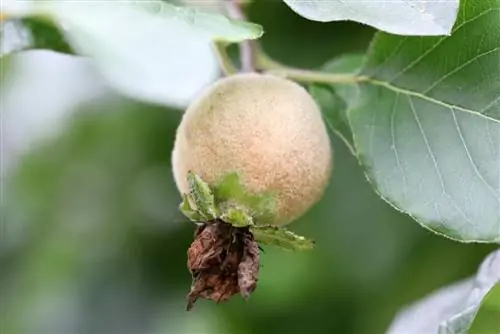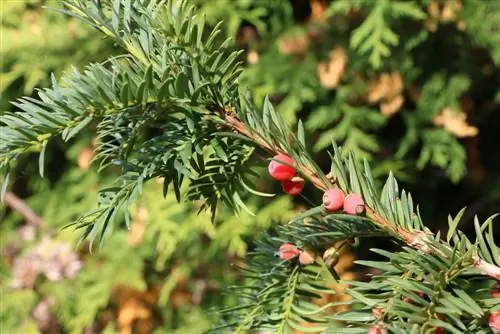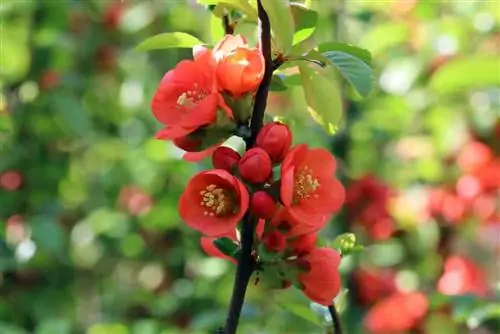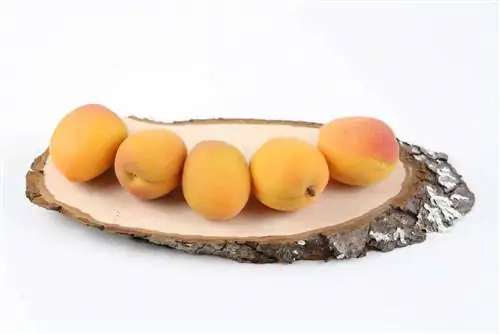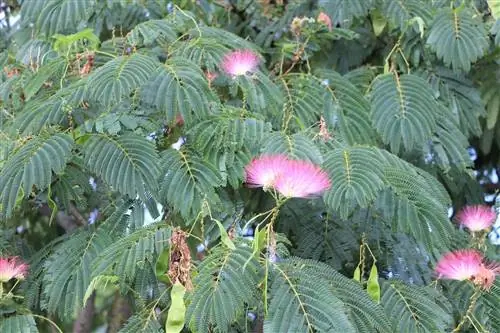- Author admin [email protected].
- Public 2023-12-17 03:39.
- Last modified 2025-01-24 12:45.
Many fruit trees require annual pruning in order for them to bear fruit. Not so with the quince tree (Cydonia oblonga), which is content with thinning out the crown. The ancient cultivated fruit grows very slowly, but tends to be dense. A rejuvenation cut is only necessary for very old specimens that have not been cut for a long time.
Why is it important to prune a quince tree?
Regular pruning like with the apple tree is not necessary for the quince. However, the tree naturally tends to be taller rather than wide and therefore has a tendency to form a dense crown. This in turn means that the shoots and leaves compete with each other for light, and moisture also has a very difficult time drying out. Moisture, however, is a breeding ground for various fungal and bacterial diseases, such as leaf browning, which often occurs on quinces. Since the quince only produces fruit on two- to three-year-old shoots, pruning contributes to continuous rejuvenation.
How often should you prune the quince tree?
Quince trees grow very slowly, which is why annual pruning is counterproductive. Instead, experienced orchardists recommend thinning out the tree crown thoroughly every two to three years.
When is the best time to prune?
The best time for pruning trees is early spring, usually between the beginning and end of March. The tree is not yet in full sap this early in the year, so the risk of bleeding is low. In addition, the new growing season is just around the corner, during which it can sprout new plants. Be sure to only prune in mild weather. At temperatures below zero, the somewhat brittle wood of the quince tends to splinter, and cold damage can also occur due to frost penetrating the freshly cut wood. Alternatively, pruning is also possible in autumn, directly after the last fruits have been harvested.
Note:
Even in summer, you sometimes have to use secateurs: If so-called water shoots or water shoots appear (which are always an indication of excessive pruning in spring!), they should be removed. However, don't cut them away, just tear them out carefully. Saplings that sprout from the base should also be cut away, as they only rob the tree of unnecessary strength.
The most important types of pruning
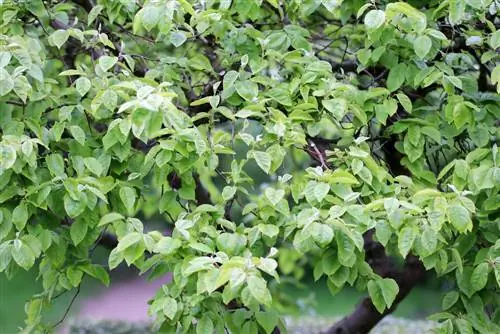
Each form of fruit tree pruning has different effects, depending on what you want to achieve and how you carry out the pruning.
Plant cutting
Some fruit trees, for example, need pruning when they are planted so that they can sprout again more quickly. However, this does not apply to quinces! It is best to let a young quince tree grow completely in peace for the first three to four years - until it has produced fruit for the first time. Then the time has come for the first tree trimming. Exception: You should always cut a young quince tree when it develops many very thin, criss-crossing shoots. These must be thinned out in spring in order to get the tree into the desired growth form.
Care or maintenance cut
The so-called care or maintenance pruning serves to constantly rejuvenate the tree and thus prevents baldness oragainst aging. Remove all old shoots and branches (unless they are leading shoots), thin out the crown and cut off diseased and dead wood. The quince tree should be pruned every two to three years. When such a cut is actually necessary depends, on the one hand, on the individual growth of the tree and, on the other hand, on the respective weather conditions in spring or autumn. If the weather is unfavorable - for example if it is cold or very rainy - it is better to refrain from any pruning measures.
Tip:
Even if you initially notice red spots on the leaves and later a brown color, you should grab scissors immediately. Otherwise, the dreaded leaf rot spreads quickly and can also spread to the fruits.
Educational Cut
A training cut is made to force a tree into a certain growth habit. Remove all shoots that grow outside of the desired direction of growth. Other educational measures can also be carried out such as hanging weights, wiring (especially with bonsai) and tying up shoots and branches. For young quinces, it is recommended to train them into a wide crown using the measures described and - if necessary - by cutting them. This is achieved as follows:
- select three to four strong guiding branches
- these should grow as horizontally as possible
- if necessary, bring it horizontal with the weights attached
- remove all other branches
- especially branches and shoots growing downwards and inwards
- Thinning out the crown
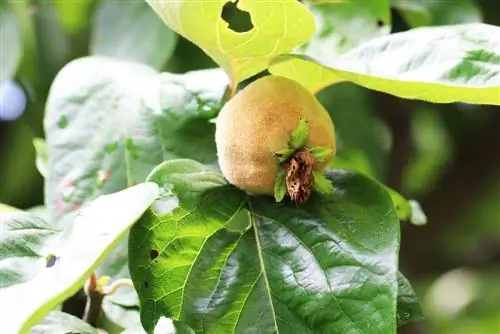
In this way, a lot of sunlight reaches the upper, fruit-bearing areas of the quince. In addition, the wood and foliage can dry faster after a rain shower.
Tip:
You can also train a young quince tree very well on a trellis. To do this, tie the three to four selected leading shoots to a trellis as described above and regularly check the shoot growth - in order to correct it if necessary. New shoots are also attached to the climbing aid.
Rejuvenation cut
Rejuvenation pruning is always carried out on old fruit trees that have not been pruned for a long time and are therefore bare. Such neglected trees usually only produce a few or even no fruits at all, which - since the fruit-bearing wood is often rather thin and weak - causes the shoots to break. Rejuvenating a tree isn't done with a single cut; instead, you have to keep using pruning shears over a period of three to four years. In addition, the quince produces no or only a few, inferior fruits during the process. But the success becomes even more sustainable from the third year onwards!
Tip:
It's best not to let it get to that point. Instead, prune your quince every two to three years as described for care pruning and you will enjoy your tree for a long time.
Can I radically cut back a quince tree?
For some heavily bare trees, it is recommended to cut them off radically. New wood eventually grows from the remaining stump and the tree is rejuvenated. It is not advisable to take such a radical approach with the quince: Since the tree only grows very slowly, in this case you would have to wait a long time until it has recovered. Nevertheless, radical tree pruning can be useful for very old specimens that cannot be saved otherwise.
Instructions for a radical cut on the quince:
- never cut the trunk
- Quinces are often grafted, then only the rootstock sprouts after cutting
- Instead, remove all branches and shoots from the crown
- leave only three to four leading shoots
- shorten this a lot
- remove all side shoots/saplings
Note: It is best to spread the pruning measures described over a period of two to three years, as the tree will then be able to cope with them better. Otherwise, after a radical cut, the specimen in question may die. The “one-third rule” applies, which you can find explained in more detail under “How to rejuvenate an old quince tree”.
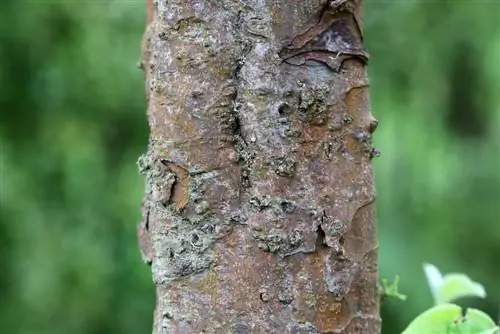
When is the best time for such a radical cut depends on the weather. You can do it in autumn or early spring, as long as it is not frosty or rainy.
Step-by-step instructions: How to thin out the crown
With regular thinning of the crown and the timely removal of shoots (these are side shoots that sprout from the base) and water shoots (thin, upward shoots), your quince tree will stay young for a long time and bear lots of fruit. You can recognize young shoots by the fine fluff they are covered with. Older ones no longer have this, but instead turn black-brown over the years. When cutting, it is best to proceed as follows:
- Cutting away dead wood and diseased wood
- cut away or shorten over-aged shoots
- remove all water shoots and shoots
- remove inwardly growing and crossing shoots
- cut away shoots that are too close together
- Make sure the crown shape is even
- shorten excessively long, thin shoots
Always pay attention to hygiene when cutting! Always use sharp, disinfected cutting tools and do not touch fresh cuts with your fingers. Blunt scissors etc. cause bruises to the tree, which heal poorly. In addition, pathogens can penetrate the wood if tools are not cleaned.
Note:
Contrary to the recurring advice of older gardeners in particular, according to the latest findings, cuts on trees should not be treated with a wound closure agent. A plaster made of tree resin or tar often has the opposite effect than the one hoped for, especially since a he althy tree has sufficient self-healing powers. The hygiene measures described as well as clean and sharp cutting tools are much more important.
Step-by-step instructions: How to rejuvenate an old quince tree
Rejuvenating an old, aging quince tree usually takes two to three years, as you should not remove more than a third of the existing branches per pruning. Remember that the root system has grown in line with the tree crown and that the underground parts of the tree that are also affected by the pruning die off - as a result, the entire tree can be severely weakened and no longer have the strength to produce new growth. You should only consider a radical cut if the alternative would be to clear the tree. But now for the instructions for rejuvenating tree pruning:
The first and second years
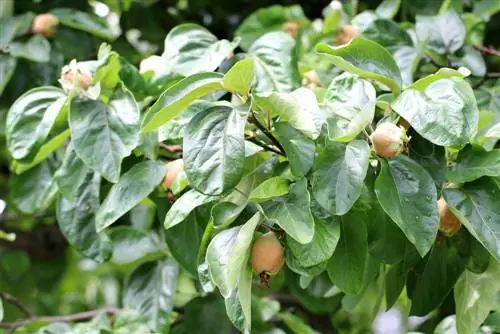
Prune in fall or spring, whenever the weather is most favorable. Before you cut, look at the tree calmly from a few meters away.
- determine a strong central shoot
- remove competing central shoots
- if there is very strong competition, only remove two or three
- the rest in the following year
- Remove branches with fruit tree cancer (recognizable by thick growths)
- here too, only two or three, as long as they are very thick
- select three to four horizontally growing leading branches
- shorten this a little if necessary
- Remove competitive instincts
- Remove dead wood and broken branches
If you need to remove more than a third of the wood, split the cutting work over two years.
The second and third years
In the second year after the rejuvenation cut, the tree develops many water shoots that grow vertically upwards and are very thin. You should remove these in the summer, and it's best to pull them out - not cut them off! Any fruit sets should also be removed in the first and second year of pruning so that the tree has enough strength for new growth.

